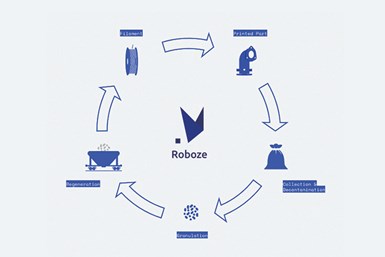Roboze Initiating Circular Economy Program for 3D Printed Parts
The manufacturer is launching a new project for the recovery of waste material and 3D printed parts to be reintroduced on the market for the benefit of end-users and especially the environment.

The aim of the program is to reduce manufacturing’s environmental impact.
Roboze is initiating a circular economy program beginning in January 2022 that will enable its customers to return waste material and 3D printed parts to Roboze at the end of their life cycle so the company can produce new material from the materials for “circular” 3D printing. This model is designed to enable Roboze customers to receive a “circular” material at a much lower price than the original and help safeguard the environment.
The aim of the program is to reduce manufacturing’s environmental impact. Roboze says that challenge is an opportunity that can drive the intent and responsibility of production models and processes which are more energy efficient and lower overall emissions. According to the company, this is causing a shift toward a new paradigm where innovation and new technologies are born with the ultimate aim of optimizing the consumption of materials and energy.
Roboze provides 3D printing technology for super polymers and composite, working to bring production back to the point of use. Its vision and execution of decentralized distribution of production in favor of microfactories around the world includes its Roboze 3D Parts Network.
It’s looking to overturn the delocalized production model, which sees large standardized production in a single point and shipped all over the world. Instead, the company is focused on a new production paradigm, which it calls Roboze Distributed Manufacturing. This model involves specialized 3D printing centers with Roboze systems distributed all over the world, which produce parts where and when they are needed, thus reducing not only costs and times for end-users but also transport and excess inventory in the warehouse.
“We are working to refine the management of the entire supply chain,” says Alessio Lorusso, Roboze founder and CEO. “3D printing technology can be one of the solutions to combat CO2 emissions, reducing transport and producing just in time and on-demand.”
Related Content
-
3D Printed Heat Exchanger Illustrates Siemens' CATCH and Release Approach
Solutions for energy efficiency, sustainability, part repair and more are developing at Siemens’ Charlotte Advanced Technology Collaboration Hub (CATCH) in North Carolina.
-
How Large-Format 3D Printing Supports Micro-Scale Hydropower
There is potential hydroelectric power that has never been unlocked because of the difficulty in capturing it. At Cadens, additive manufacturing is the key to customizing micro-scale water turbine systems to generate electricity from smaller dams and waterways.
-
GE Additive Helps Build Large Metal 3D Printed Aerospace Part
The research is part of an initiative to develop more fuel-efficient air transport technologies as well as a strong, globally competitive aeronautical industry supply chain in Europe.







.png;maxWidth=300;quality=90)






